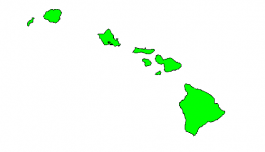Koster's Curse
Clidemia hirta
http://blip.tv/play/geMCgdPabQI.html?p=1
The botanical curse of Koster
Sometime between 1880 and 1886, a man by the name of Koster was working to establish a coffee plantation on Fiji when he accidentally introduced some of the seeds of Clidemia hirtia in his coffee stock. By about 1920 islanders realized the widespread problems of this plant, particularly in coconut groves, and called it “the curse.” Later Koster’s name was attached to it, and it was called Koster’s Curse. Since its early introduction to Fiji, it has spread to many other tropical islands and caused major problems as an invasive species.
General Description
Koster’s Curse, or Soapbush, is perennial shrub that can grow up to 6 feet tall, although it generally grows from 1 to 3 feet in height. One of the most distinctive characteristics of this plant are its leaves; they are slightly hairy with 5 major veins originating at the base of the leaf and extending all the way to its tip. The flowers are small and white, with five petals. When pollinated, these flowers give rise to small bluish-black berries.
Where is Koster’s Curse found?
Koster’s Curse is originally from Central and South America. It ranges all the way from Mexico to Paraguay. However, it was introduced to Fiji, Australia, Southeast Asia, and Hawaii. It has caused tremendous problems to the fragile ecosystems of Hawaii. It was first recorded from the island of Oahu in 1940. By the mid 1970s it was reported to have covered 90,000 acres. Now it is found on all major Hawaiian islands.
Why is Koster’s Curse a problem?
The major problem with Koster’s Curse is that it can spread rapidly in disturbed soil without any natural predators. When it does spread it will form monotypic stands that shade out all understory plant growth. This inhibits the rest of the forest from regenerating in these disturbed areas. It has been spread primarily by invasive pigs that track the seeds in their hoofs. Hikers also spread the seeds as they move among trails and islands. It is very important that hikers wash their boots before and after each hike in pristine rain forest areas where Koster’s Curse is found.
What is being done to stop the spread?
In the past the best way to stop the spread of Clidimia hirta was to use a combination of mechanical and chemical control. Plants were pulled up and then supplemented by herbicides in the area. Today a species of thrips (Liothrips urichi), originally from Trinidad, is being employed to control the spread of this species. Typically, with the introduction of biological control, the introduced insect predator rarely completely eliminates the species. However, it does decrease its competitive advantage in the problem areas.
Related Topics
http://blip.tv/play/geMCgdPabQI.html?p=1
The botanical curse of Koster
Sometime between 1880 and 1886, a man by the name of Koster was working to establish a coffee plantation on Fiji when he accidentally introduced some of the seeds of Clidemia hirtia in his coffee stock. By about 1920 islanders realized the widespread problems of this plant, particularly in coconut groves, and called it “the curse.” Later Koster’s name was attached to it, and it was called Koster’s Curse. Since its early introduction to Fiji, it has spread to many other tropical islands and caused major problems as an invasive species.
General Description
Koster’s Curse, or Soapbush, is perennial shrub that can grow up to 6 feet tall, although it generally grows from 1 to 3 feet in height. One of the most distinctive characteristics of this plant are its leaves; they are slightly hairy with 5 major veins originating at the base of the leaf and extending all the way to its tip. The flowers are small and white, with five petals. When pollinated, these flowers give rise to small bluish-black berries.
Where is Koster’s Curse found?
Koster’s Curse is originally from Central and South America. It ranges all the way from Mexico to Paraguay. However, it was introduced to Fiji, Australia, Southeast Asia, and Hawaii. It has caused tremendous problems to the fragile ecosystems of Hawaii. It was first recorded from the island of Oahu in 1940. By the mid 1970s it was reported to have covered 90,000 acres. Now it is found on all major Hawaiian islands.
Why is Koster’s Curse a problem?
The major problem with Koster’s Curse is that it can spread rapidly in disturbed soil without any natural predators. When it does spread it will form monotypic stands that shade out all understory plant growth. This inhibits the rest of the forest from regenerating in these disturbed areas. It has been spread primarily by invasive pigs that track the seeds in their hoofs. Hikers also spread the seeds as they move among trails and islands. It is very important that hikers wash their boots before and after each hike in pristine rain forest areas where Koster’s Curse is found.
What is being done to stop the spread?
In the past the best way to stop the spread of Clidimia hirta was to use a combination of mechanical and chemical control. Plants were pulled up and then supplemented by herbicides in the area. Today a species of thrips (Liothrips urichi), originally from Trinidad, is being employed to control the spread of this species. Typically, with the introduction of biological control, the introduced insect predator rarely completely eliminates the species. However, it does decrease its competitive advantage in the problem areas.

































































































